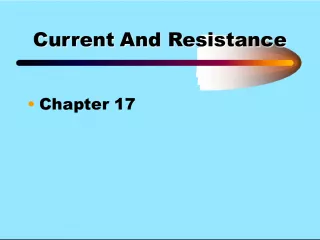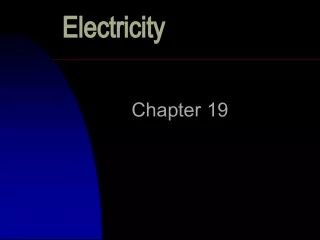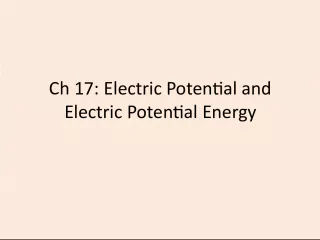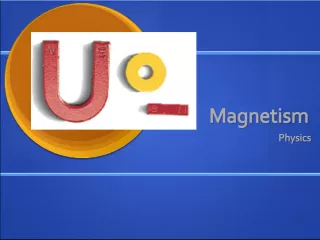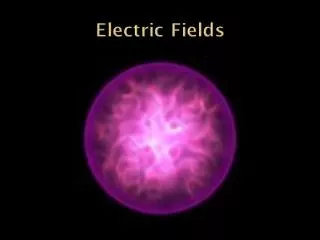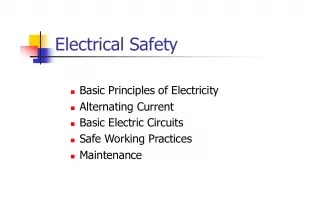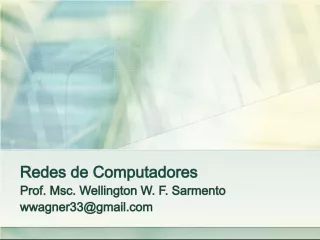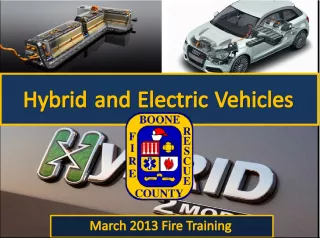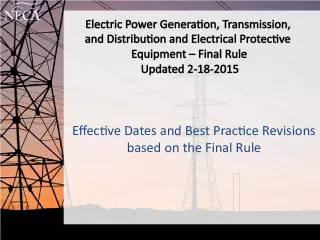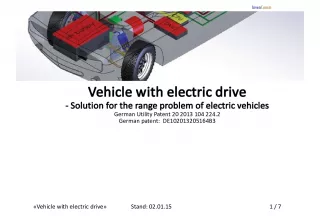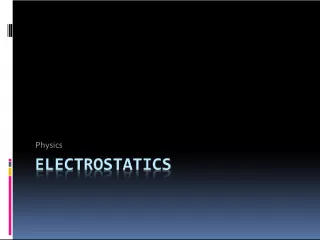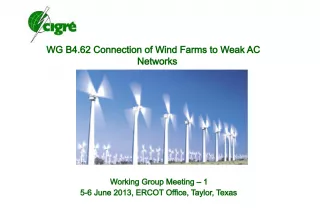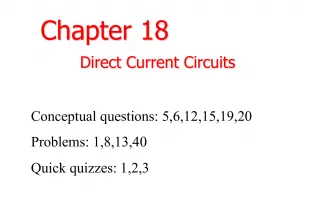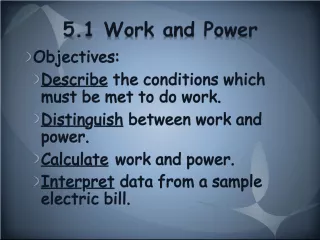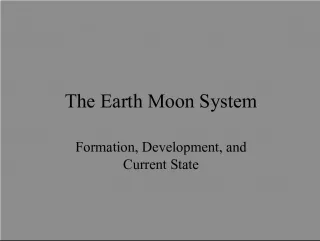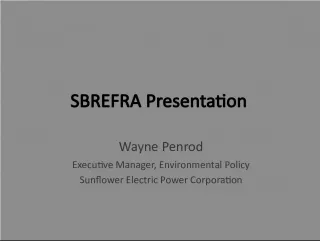Understanding Electric Current


This article explains how charge flows in an electric conductor due to potential difference, and how electric current is measured in amperes as the flow of 1 coulomb of charge per second.
- Uploaded on | 3 Views
-
 anandbal
anandbal
About Understanding Electric Current
PowerPoint presentation about 'Understanding Electric Current'. This presentation describes the topic on This article explains how charge flows in an electric conductor due to potential difference, and how electric current is measured in amperes as the flow of 1 coulomb of charge per second.. The key topics included in this slideshow are . Download this presentation absolutely free.
Presentation Transcript
1. Physics
2. Flow of Charge Charge flows when there is a potential difference When the ends of an electric conductor are at different electric potentials, charge flows from one end to the other The flow of charge will continue until both ends reach a common potential
3. Electric Current (I) Electric current = the flow of electric charge e- carry the charge through the circuit because they are free to move throughout the atomic network Electric current is measured in amperes (A) ampere = the flow of 1 coulomb of charge per second current = charge time current = charge time I = Δq Δt I = Δq Δt
4. A current-carrying wire has a net electric charge of zero because the number of electrons entering one end is the same as the number leaving the other. A current-carrying wire has a net electric charge of zero because the number of electrons entering one end is the same as the number leaving the other. What is the net charge of a current carrying wire (as pictured above)? What is the net charge of a current carrying wire (as pictured above)?
5. Current (I) vs. Voltage (V) Charges flow when there is a potential difference (V) A voltage source provides a potential difference Ex: batteries, generators Charges flow through a circuit because of an applied voltage across the circuit Voltage (V) causes current (I) If I increase the potential difference (voltage), will the current… (a) increase or (b) decrease? If I increase the potential difference (voltage), will the current… (a) increase or (b) decrease? Increase! V α I Increase! V α I
6. Resistance (R) We now know: Amount of charge that flows in a circuit depends on the voltage provided by the voltage source (V α I) But… The current also depends on the resistance (R) that the conductor offers to the flow of charge—the electric resistance Resistance is measured in ohms (Ω)
7. Resistance (R) of a wire depends on: Conductivity of the material used in the wire Better conductors have less resistance Thickness of the wire Thick wires have less resistance than thin wires. Length of the wire Longer wires have more resistance than short wires Temperature For most conductors, increased temperature means increased resistance Why will an electric drill operating on a very long extension cord not rotate as fast as one operated on a short cord? Why will an electric drill operating on a very long extension cord not rotate as fast as one operated on a short cord? The longer an extension cord, the greater its resistance, and the more energy is dissipated in it, with less available for the electric drill. The longer an extension cord, the greater its resistance, and the more energy is dissipated in it, with less available for the electric drill.
8. What do we know? How is current (I) related to voltage (V)? How is current (I) related to voltage (V)? How is current (I) related to resistance (R)? How is current (I) related to resistance (R)? Combining these findings… Combining these findings… I α V I α V I α 1/R I α 1/R I = V/R I = V/R
9. Ohm’s Law The current in a circuit is directly proportional to the voltage impressed across the circuit, and is inversely proportional to the resistance of the circuit I = V/R I = V/R V = I*R V = I*R Units: V = volts (V) I = amps (A) R = ohms (Ω) Units: V = volts (V) I = amps (A) R = ohms (Ω)
10. Examples If the voltage impressed across a circuit is constant but the resistance doubles, what change occurs in the current? V = IR V = 2R*_I V = 2R * ½ I V = IR V = 2R*_I V = 2R * ½ I The current is halved The current is halved How much voltage is required to make 2 amperes flow through a resistance of 8 ohms? V = IR V = 2 A * 8 Ω V = IR V = 2 A * 8 Ω V = 16 volts V = 16 volts
11. Ohm’s Law and Electric Shock The damaging effects of electric shock are the result of current passing through the body Body’s resistance = 100 ohms if you’re soaked with salt water to about 500,000 ohms if your skin is very dry
12. Why don’t birds get fried? Every part of the bird’s body is at the same high potential as the wire, so the bird feels no effects For the bird to receive a shock, there must be a difference in potential between one part of its body and another part Jane falls from a bridge and manages to grab onto a high-voltage power line, halting her fall. Will she be ok?? Jane falls from a bridge and manages to grab onto a high-voltage power line, halting her fall. Will she be ok?? As long as Jane touches nothing else of different potential, she will receive no shock at all. Even if the wire is thousands of volts above ground potential and even if she hangs by it with two hands, no charge will flow from one hand to the other. If, however, you reach over with one hand and grab onto a wire of different potential, ZAP!! As long as Jane touches nothing else of different potential, she will receive no shock at all. Even if the wire is thousands of volts above ground potential and even if she hangs by it with two hands, no charge will flow from one hand to the other. If, however, you reach over with one hand and grab onto a wire of different potential, ZAP!!
13. Source of e- in a circuit The source of electrons in a circuit is the conducting circuit material itself Electrons DO NOT come from: electric outlets in the walls of homes power lines Power utilities do not sell electrons. They sell energy . You supply the electrons. When you are jolted by an AC electric shock, the electrons making up the current in your body originate in your body. Electrons do not come out of the wire and through your body and into the ground; energy does.
14. Electric Power A charge moving in a circuit expends energy This may result in heating the circuit or in turning a motor Electric power (P) = the rate at which electrical energy is converted into another form such as mechanical energy, heat, or light Measured in Watts (W) Electric power is equal to the product of current and voltage P = V*I P = V*I P = I 2 *R P = I 2 *R
15. Example Calculate the power supplied to an electric blanket that carries 1.20 A when connected to a 120-V outlet. P = V*I P = V*I P = 120 V*1.20 A P = 120 V*1.20 A P = 144 W P = 144 W
16. Physics
17. Electric Circuits Circuit = Any path along which electrons can flow For a continuous flow of electrons, there must be a complete circuit with no gaps A gap is usually provided by an electric switch that can be opened or closed to either cut off or allow electron flow
18. In Series
19. In Series Total resistance to current in the circuit is the sum of the individual resistances along the circuit path R total = R1 + R2 + R3 Current passing through each electric device is the same I1 = I2 = I3 V total = I*R total Ohm’s Law applies across each individual device V1 = I*R1 V2 = I*R2 V3 = I*R3 Sum of the voltage drops across the individual devices is equal to the total voltage supplied by the source V total = V1 + V2 + V3
20. Example 1: Series Find the total resistance of the three resistors connected in series.
21. Example 2: Series What is the current through the battery? R = 4 Ω
22. Example 3: Series Find the resistance of the unknown resistor, R.
23. In Parallel
24. In Parallel Overall resistance of the circuit is less than the resistance of any one of the branches 1/R total = 1/R1 + 1/R2 + 1/R3 Voltage is the same across each device V1 = V2 = V3 Total current in the circuit equals the sum of the currents in its parallel branches I total = I1 + I2 + I3 Ohm’s Law applies across each individual device V = I1*R1 V = I2*R2 V = I3*R3
25. Example 1: Parallel Find the total resistance of the three resistors connected in parallel.
26. Example 2: Parallel Find the current through the 2 ohm resistor.
27. Example 2: Parallel Three resistors are connected in parallel. If placed in a circuit with a 12-volt power supply. Determine the equivalent resistance, the total circuit current, and the voltage drop across and current in each resistor.
28. Combining Resistors Series R total = R1 + R2 + R3 Parallel
30. Example 1: Circuits Find the total current passing through the circuit.
31. Example 2: Circuits Find the current passing through the 9 ohm resistor.
